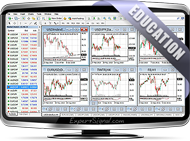Trading the Bitcoin Calendar Spread
The calendar spread is a useful gauge of how bullish or bearish traders are in a forward starting-time period. In early February, Bitcoin lost close to 70% of its value measured against its December 2017 all-time high. The spread reached a low of 0.42% annualized during the same period.
The source for this analysis is BitMEX: ► BitMEX Crypto Exchange
Chart: March (XBTH18) and June (XBTM18) Bitcoin/USD contract spread

Source: BitMEX
The above chart shows the Bitcoin price and the annualized premium of the March (XBTH18) and June (XBTM18) Bitcoin/USD contract spread.
The calendar spread is calculated by the following function:
- Annualised Premium = [(XBTM18 Price - XBTH18 Price) / Bitcoin Spot] / 0.2493
- 0.2493 represents the annualized time value between the March and June expiry dates.
Trading the chop is a skill in and of itself. The chop will make it look sickly before the next breakout happens. Therefore, using derivative spread trades with a view on the direction of the spot market is a better risk-adjusted way to express a view.
For those who believe we are in the midst of a full retrace back to $20,000, going long on the XBTM18/XBTH18 calendar spread is prudent. To go long, you must go long XBTM18 and simultaneously go short on XBTH18.
If the market indeed continues to push higher, XBTM18’s price will increase faster than that of XBTH18’s. That is because XBTM18 possess more time value, so the interest-rate component will make up a significant percentage of its value relative to XBTH18.
This trade comes relatively cheap. Currently, the spread is trading at positive 3.15% annualized. Because the spread is positive, the trade has negative theta or time value. XBTH18 expires at the end of March. By the end of March, if XBTM18 doesn’t outperform, you will lose an outright 0.78%, making your daily theta 0.026%.
Historically, the quarterly contracts trade at a 30% to 40% annualized premium. If we assume the curve’s annualized premium stays constant, the calendar spread should trade at a similar premium. Therefore, in the upside scenario, we expect a 10-fold increase in the annualized calendar-spread premium.
The reason why you put this trade on rather than going naked long is that the market-to-market losses on this trade are capped at 0.78%. Imagine you bought Bitcoin at $10,000, then it crashed to $6,000. As a weak hand, you panic-sold the bottom. But the price quickly recovered back to $10,000, and even though your trade broke even over less than one month, you lost 40% because you could not mentally handle the mark to market.
With a calendar spread, you know from the outset your maximum loss. If you are uncomfortable with that loss a priori, you can refrain from putting on the trade.
For those who want to juice up the returns, add more leverage to both legs. However, be cognizant that BitMEX does not use portfolio margin - that is, gains in one contract will not offset your liquidation price on the other. You must monitor the liquidation price of the contract with an unrealized loss and continue to top up your account to avoid liquidation.
A primer on leveraged and inverse ETFs
One of the biggest reasons why ETFs are so successful in the US is that investors can purchase them in their retirement accounts. Retirement accounts have various restrictions on the type of assets that may be purchased. Usually, these accounts do not allow investors to hold futures contracts or trade on margin.
To satiate this demand, ETF issuers began launching leveraged and inverse ETFs.
Let’s assume we launch an inverse ETF on the S&P 500 index (SPX). The purchaser of this ETF will profit if the index declines.
Daily ETF Performance = -1 * Daily Return SPX
Say that on day 1:
SPX Close0 = $1,000
SPX Close1 = $500
Return = -50%
ETF Performance = -1 * -50% = +50%
And on day 2:
SPX Close1 = $500
SPX Close2 = $1,000
Return = 100%
ETF Performance = -1 * +100% = -100% (Bankrupt!)
This simple example illustrates that inverse ETFs are path dependent. In other words, holders take on convexity while holding this ETF. Unfortunately, they are short, not long.
Leveraged and inverse ETFs are ticking time bombs. If held long enough during a period of suitable volatility, there is a significant likelihood that holders will severely underperform their intended strategy.
In addition, the fund manager must constantly re-hedge his portfolio at the end of each trading day. The more a manager trades, the more fees must be paid to investment banks and the exchange. These fees are passed on to the client.
The client is short gamma, underperforms the benchmark, and pays more in fees.
The Volocaust
Selling volatility has been the sure bet to riches for retail and institutional investors alike since 2009. The CBOE VIX futures market took off after the crisis, and enterprising ETF issuers began listing products to allow retail punters to participate in this esoteric corner of the financial markets.
Retail punters took VIX ETFs like a Donald Trump to Propecia.
As volatility continued to collapse, exchange-traded notes (ETNs) and exchange-traded products (ETPs) that allowed retail investors to short VIX futures proliferated. Retail punters got a double whammy of goodness.
The first whammy: VIX futures contango. Because investors feared another 2008 market crash, they bid up call and put prices. This led to enhanced implied volatility, which meant VIX futures traded at a premium to spot. Because volatility continued to realize lower and lower, VIX futures sellers picked up that premium.
The second whammy: central banks, crushing all market volatility. At any hint of crisis, the printing press went spastic and punished shorts.
One of the most popular products was the VelocityShares Daily Inverse VIX Short-Term ETN (XIV, get it?) that Credit Suisse issued. XIV invests in the VIX short-term futures contracts, not the index itself. This is awesome when the market doesn’t move and the futures basis tends to zero, but if the term structure shifts dramatically higher, it will exacerbate the losses.
Things were going well until the market dropped last week, and the VIX and its associated futures spiked. It went up so much that the net asset value (NAV) of the ETN declined by over 80% in one day. Remember, the ETN decreases in price if the VIX rises. There is a clause in the prospectus that allows the issuer to redeem the ETNs if the NAV drops by more than 80% in one trading session. Investors at that point get back what they can get back. Given that the short-term VIX futures basis spiked as well, these investors are pretty much guaranteed to receive a bagel.
Entire fortunes and accounts were destroyed overnight. Traders who saw steady profits as volatility ground lower were wiped out.
About BitMEX
BitMEX is a trading platform that offers investors access to the global financial markets using only Bitcoin. BitMEX is built by finance professionals with over 40 years of combined experience and offers a comprehensive API and supporting tools.
Trade Platform:
-Peer-to-Peer Trading Platform that offers leveraged contracts (Bitcoin 100:1)

□ Bitcoin Spot / Bitcoin Futures, Ethereum, Litecoin, Ripple, Dash, Zcash, Qtum, Monero, Tezos, and more
► Visit BitMEX Crypto Exchange
Risk Disclaimer
BitMEX is not a licensed financial advisor. The information presented in this newsletter is an opinion and is not purported to be fact. Bitcoin is a volatile instrument and can move quickly in any direction. BitMEX is not responsible for any trading loss incurred by following this advice.



